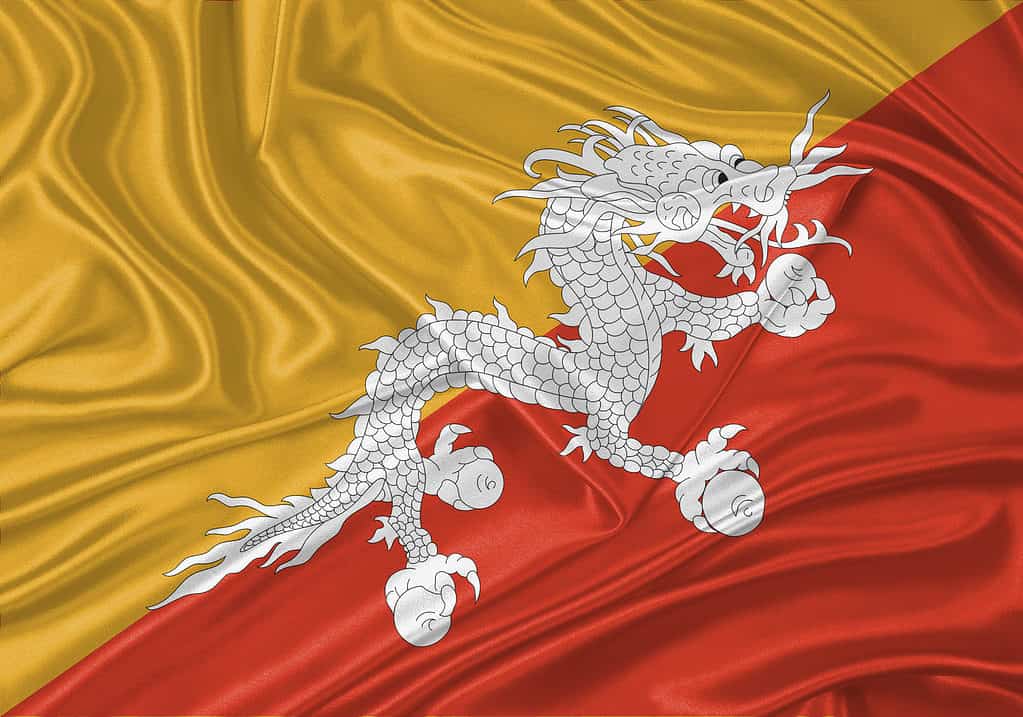Located in southern Asia amid Tibet and India, Bhutan is a little, landlocked country. The Great Himalayas, the Inner Himalayas, and the Southern Foothills make up the country’s terrain from north to south. The kingdom of Bhutan is often called Druk-Yal, meaning “land of the thunder dragon.” Of all the things that represent Bhutan, one of its most recognizable emblems is its flag. From Bhutanese mythology, the country’s flag contains a Chinese dragon or Druk. This is a reference to the lineage of the Drukpa (branch of Tibetan Buddhism), the predominant religion in Bhutan. In this post, we will learn all about the Bhutanese flag, from its origins to its significance in the country’s culture.
Flag of Bhutan History

The first national flag of Bhutan was established in 1949. Certain changes have been made since then.
©Hybrid Gfx/Shutterstock.com
1949
Wangchuck, the second Druk Gyalpo (Bhutanese ruler) of 20th-century Bhutan, requested the first national flag, which was established in 1949 during the Indo-Bhutan Treaty. The original Bhutanese flag was said to be a bicolor square split diagonally from the lower hoist to the upper fly. Yellow covered the hoist to the higher fly, while red covered the fly to the lower hoist. At the intersection of the red and yellow fields, a green-colored Druk faced the fly.
There is some mixed information regarding the description of the 1949 flag, and some do not match the pictures. For example, the flag is described as “square,” according to certain sources, but photos show a 4:5 ratio. Some documents say the dragon faces the fly end, but photographs show it facing the hoist.
1956
In 1956, in preparation for an eastern Bhutan trip for the third Druk or Gyalpo (Jigme Dorji Wangchuk), a new version of the national flag was created. The new design was based on a photo of the first flag from 1949 but the dragon was changed from the color green to white. This was initially used by the Druk Gyalpo’s Secretariat throughout the Druks journey. Over a hundred ponies served as part of the Druk Gyalpo’s convoy, with a little flag affixed to the bridle of every tenth animal. Each night, to the sound of a bugler, a larger flag measuring about 6 square feet was hoisted and flown in the camp.
1969 to Present
Several flag modifications were proposed in the late 1950s by Dasho Shingkhar Lam, the Sixth Speaker of the National Assembly. These changes have not been altered since 1969. During a visit from an Indian official, the king reportedly became frustrated when the flags, which had initially been square in shape, failed to wave in the same way as the Indian flag. To conform to India’s 9-by-6-foot flag, Bhutan’s size was adjusted accordingly.
The dragon was also shifted from the flag’s center to the diagonal line separating the flag’s background colors. By making this modification, the dragon would no longer be facing down while the flag is limp. A Bhutanese artist by the name of Kilkhor Lopen Jada softened the dragon’s edges so that the resulting druk is lengthier and more softly flowing.
Some say the king changed the color of the bottom part of the painting from red to orange between 1968 and 1969. The first time the Bhutanese flag flew overseas alongside the flag of another country was during Jigme Dorji Wangchuck’s visit to India in 1961.
Flag of Bhutan Design
The current flag has a yellow upper triangle and an orange lower triangle separated diagonally from the lower hoist-side corner. A big black and white dragon with its back to the hoist side is centered at the dividing line. Each of the dragon’s claws is clutching a Norbu, or precious jewel. The flag has a yellow and orange background. The flag’s proportions remain at a 3:2 ratio.
Flag of Bhutan Symbolism
Civilization and temporal authority are symbolized by the flag’s yellow section. The orange section of the flag symbolizes the Drukpa Kagyu and Nyingma traditions of Buddhism.
The dragon covers the color line evenly. Located in the middle of the flag, above the line that separates the flag’s two colors, the dragon represents the holy bond between the sovereign and the people of the Kingdom of Druk. The white color of the dragon represents the unity of the people of Bhutan, despite their many different ethnicities and languages.
Druk’s sharp teeth reflect the protection of Bhutan’s deities, while the diamonds in his claws represent the country’s wealth and the safety of its people.
Click here to learn about every single flag in the world!
Up Next:
- The Flag of Greenland: History, Meaning, and Symbolism
- The Flag of Iraq: History, Meaning, and Symbolism
- The Flag of Benin: History, Meaning, and Symbolism
The photo featured at the top of this post is © Black Pearl Footage/Shutterstock.com
Sources
- Wikipedia, Available here: https://en.wikipedia.org/wiki/Flag_of_Bhutan
- Britannica, Available here: https://www.britannica.com/topic/flag-of-Bhutan
- Flags of the World, Available here: https://www.fotw.info/flags/bt.html
Thank you for reading! Have some feedback for us? Contact the AZ Animals editorial team.






